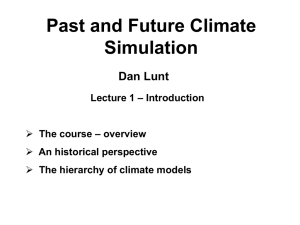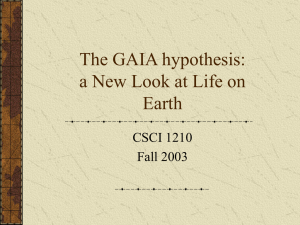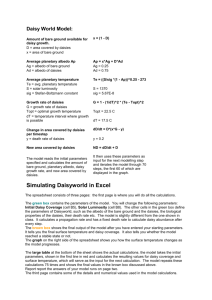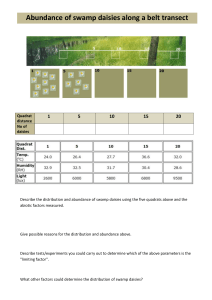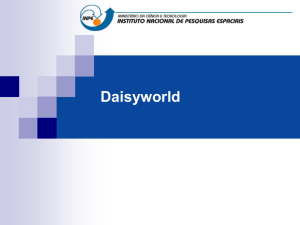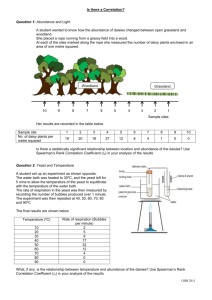Students explore a fictional “Daisy World” in
advertisement
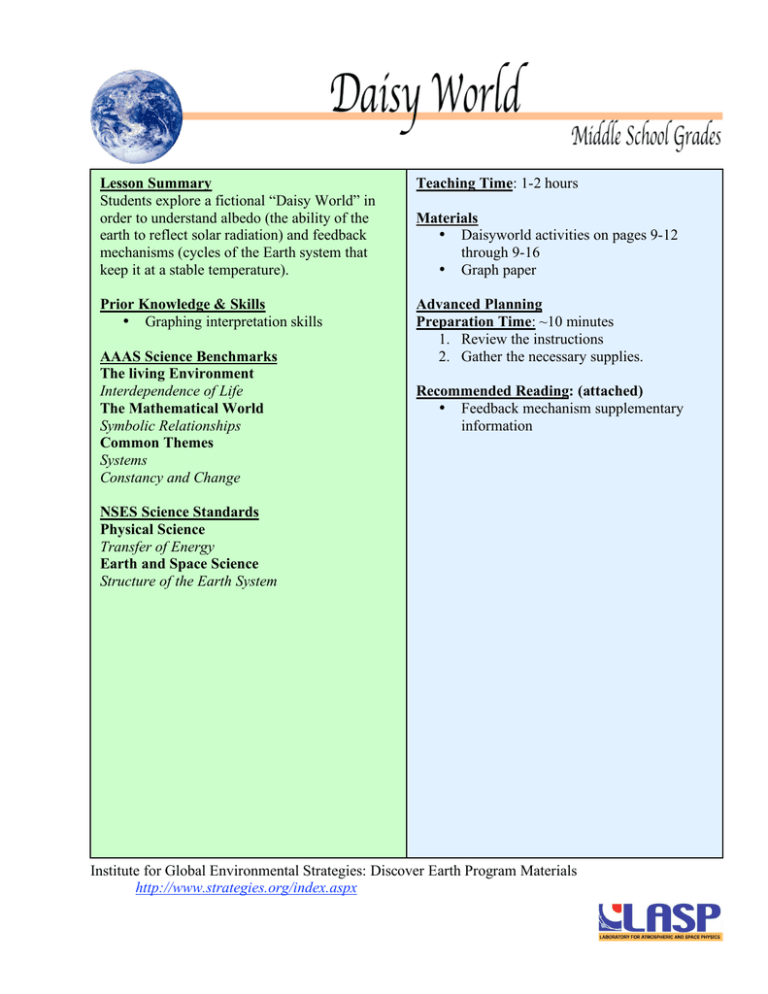
Lesson Summary Students explore a fictional “Daisy World” in order to understand albedo (the ability of the earth to reflect solar radiation) and feedback mechanisms (cycles of the Earth system that keep it at a stable temperature). Teaching Time: 1-2 hours Prior Knowledge & Skills • Graphing interpretation skills Advanced Planning Preparation Time: ~10 minutes 1. Review the instructions 2. Gather the necessary supplies. AAAS Science Benchmarks The living Environment Interdependence of Life The Mathematical World Symbolic Relationships Common Themes Systems Constancy and Change Materials • Daisyworld activities on pages 9-12 through 9-16 • Graph paper Recommended Reading: (attached) • Feedback mechanism supplementary information NSES Science Standards Physical Science Transfer of Energy Earth and Space Science Structure of the Earth System Institute for Global Environmental Strategies: Discover Earth Program Materials http://www.strategies.org/index.aspx The Earth System The Earth System Authors: Pat Fraser, Franklin Academy, Malone, New York Linda Knisely, Annapolis High School, Annapolis, Maryland Richard Taylan, F. D. Roosevelt High School, Hyde Park, New York Additional Materials Eric Barron, Director, Earth System Science Center, The Pennsylvania State University Grade Level: 8 - 12 http://www.strategies.org/discoverearth/lesson9.html (1 of 25) [8/1/07 11:33:02 AM] The Earth System Key Concepts and Terms: albedo effect Albedo is the fraction of solar energy that is reflected back to space. The more reflective a surface, the higher the albedo (the range is 0 - 1). The elements of the climate system that most contribute to Earth's albedo are clouds, surface ice and snow, and aerosol haze. Variations in the albedo of these elements can have a significant impact on global climate. For example, the albedo for fresh snow can be as high as .87 (87% of incoming solar energy is reflected). When the portion of ocean and land that is covered by ice and snow increases, the increased area of high albedo can be a positive feedback that increases cooling and expands the area covered with ice and/or snow, which can increase cooling and further expand the area covered with ice and/or snow. This is known as the ice albedo effect. A decrease in ice and snow--which would damp (reduce) the albedo effect--would increase the amount of solar energy received, resulting in warmer temperatures that would diminish the area covered by ice and snow. This in turn would further damp the albedo effect. This is a negative feedback. cloud condensation nuclei (CCN)* In the atmosphere, clouds can form at relative humidities of less than 100%. This is due to the presence of minute water-attracting particles. Water vapor will stick to, and condense on, these particles to form clouds. Major sources of naturally occurring CCN are: ❍ volcanoes - dust and sulfate particles; ❍ oceans - sea salt and particles; ❍ phytoplankton - sulfate particles; and ❍ wildfires - soot and dust. CCN can also result from man's activities. In particular, CCN occur as a byproduct of any combustion process. This includes motor vehicles emissions, industrial activity, and controlled fires (slash and burn agriculture). Earth system science Science of Earth as a system composed of interacting subsystems. This approach emphasizes the interactive nature of the components and crosses traditional discipline boundaries. The subsystems are the atmosphere, biosphere, geosphere, and hydrosphere (chart on page 9-4); described as follows: atmosphere http://www.strategies.org/discoverearth/lesson9.html (2 of 25) [8/1/07 11:33:02 AM] The Earth System atmosphere Thin layer of gas or air that surrounds the Earth. Processes in the atmosphere include winds, weather, and the exchange of gases with living organisms. biosphere The wealth and diversity of living organisms on the Earth. Processes in the biosphere include life and death, evolution, and extinction. geosphere Physical elements of the Earth's surface, crust, and interior. Processes in the geosphere include continental drift, volcanic eruptions, and earthquakes. hydrosphere Water and ice on or near the surface of the Earth. Includes water vapor in clouds; ice caps and glaciers; and water in the oceans, rivers, lakes, and aquifers. Processes in the hydrosphere include the flow of rivers, evaporation, and rain. feedback Any process which amplifies or damps any perturbation to a system-- such as the climate system. An initial change is amplified (a + feedback) or damped (a - feedback). Within the Earth system, feedback may occur in a subsystem(s) other that where the stimulant is located. For example, increased greenhouse gases in the atmosphere-- which may lead to global warming--originate at the Earth's surface and may be ultimately stored in the ocean. See albedo effect for examples of positive and negative feedbacks. Note that all perturbations to a system are not necessarily part of a feedback loop. 9-2 perturbation Any change in a system which has an effect on the system. turgor Rigidity of plant due to water content. * courtesy of William F. Ryan, University of Maryland at College Park, Department of Meteorology. Background for Teachers: Space observations have changed the way we view Earth. Having access to data acquired by satellites that survey the entire planet, at regular intervals, has dramatically enhanced our ability to study Earth and supports the realization that humanity shares a common destiny. Scientists now use a systems view of Earth to understand the processes responsible for the evolution of the Earth on all timescales and the interaction of Earth's subsystems (atmosphere, biosphere, geosphere, hydrosphere). Understanding Earth means using a scientific approach that considers the Earth as a complex, evolving body, characterized by ceaseless change. It means understanding Earth on a global scale by describing how its component parts http://www.strategies.org/discoverearth/lesson9.html (3 of 25) [8/1/07 11:33:02 AM] The Earth System and their interactions have evolved, how they function, how they may be expected to evolve. We are interested in how the Earth system functions, what is "normal," what causes change in the system, and how the system copes with change. The Earth system is sometimes compared to the human body. We are interested in how well our heart/ lungs/muscles/nerves, etc. work--but we are most keenly interested in how well the components work together--our overall health. So it is with Earth. Disturbances to the Earth system are called perturbations. They can encompass anything from a change in the amount of solar insolation reaching Earth to the amount of carbon dioxide humans are putting into the atmosphere. Any change that has an effect on the Earth system that is either amplified or damped is part of a feedback loop--either positive or negative. Positive feedback reinforces an action or response. For example, an increase of ice or snow in cold climates can encourage cooler temperatures and more ice and snow--a positive feedback. Negative feedback is usually more stabilizing and limits the deviation of the system. For example, if those cold climates had warmer temperatures, that would likely result in less ice and snow, which would encourage the continuation of warmer temperatures. Notice that positive feedback reinforces (amplifies) a behavior but does not mean that the behavior is desirable. See Daisyworld on page 9-13 for a more detailed look at systems. 9-3 http://www.strategies.org/discoverearth/lesson9.html (4 of 25) [8/1/07 11:33:02 AM] The Earth System -- Biosphere objective: With paper and pencil Daisyworld: students will investigate the feedback effect of white and black daisies on a system. Materials: Daisyworld activities on pages 9-13 through 9-17 graph paper 1. Use the materials in a combination of class discussion, and either individual or group work on the graphing. 2. Have students diagram the system and feedback processes demonstrated in these classroom materials (activities for atmosphere, biosphere, geosphere, hydrosphere). -- Biosphere objective: Without Daisyworld: students will investigate the effect of water on plants. Materials: 2 small plants per group - mimosa plants work well 1. About 7 days before the activity, give each group of students two small plants. Have students label one plant "wet" and the other "dry." Instruct them to keep one plant dry for the experiment, the other watered. 2. After a week of watering/withholding water, students observe the differences between the plants. 3. Water the dry plant and observe. 4. Note the time for turgor to take effect. 5. Discuss reasons for the change in the plant; relate to feedback. One can imagine feedbacks - more water, healthier plants, deeper roots, more access to water, healthier plants, etc. Or in tropical deforestation: one-half the water is recycled through plant transpiration. More healthy vegetation actually help increase precipitation through recycling water, etc. 6. Alternately or additionally, students can place their wet and dry plants in clear plastic bags and observe the resulting system over a period of days. http://www.strategies.org/discoverearth/lesson9.html (13 of 25) [8/1/07 11:33:02 AM] Daisyworld Dr. Eric Barron James Lovelock constructed a simple parable to explain the ability of feedback systems to regulate essential variables, like the temperature of a planet. Daisyworld is a mythical planet, upon which grows only white daisies. There are no clouds, no mountains or ocean, only dark bare soil and white daisies. Daisies, like all living organisms, have a range of temperatures that they tolerate, and an optimum temperature for growth. Let's assume that all daisies die if the temperature is below 5 degrees Celsius or if the temperature is above 40 degrees Celsius. Let's also assume that the optimum temperature for daisies is 25 degrees Celsius. Graphically, the relationship between daisies and the temperature of their environment would look like figure 1: Daisyworld has a sun, like ours, that warms the planet. As daisies grow, they cover more and more of the surface of the planet. Consequently, if conditions are optimum for daisy growth then much of the dark, absorbing surface is replaced by white, highly reflective daisies. In other words, as the number of daisies increases, the albedo of Daisyworld increases (it is more reflective), more sunlight is reflected back to space and the planet cools. Thus, as the daisies spread across the planet, the average planetary temperature will drop. Graphically, the relationship between the number of white daisies and the temperature of the planet must look something like figure 2. We can describe Daisyworld in terms of system theory. The input to the system is solar energy, the output is heat reflected to space. The essential variable on Daisyworld is the planetary temperature. Interestingly, Daisyworld has a feedback relationship with the essential variable because daisy numbers are dependent on the temperature of the planet and the temperature of the planet depends on the number of daisies. We can understand this feedback relationship by combining the graphs shown in figures 1 and 2 to form figure 3. In figure 3, Daisyworld appears to be stable where the two graphs intersect (points A and B). We have just the right number of daisies for the planetary temperature. This condition of balance is called a steady state. The question is whether both of these steady states (points A and B) are stable if the planet's temperature is perturbed (e.g., if for some reason the solar input changes). The key to answering this question is to use a pencil to move either point A or B, as if the world warmed or cooled. For example, if we move point A (enlarged detail in figure 4-b) a short distance to the right, the world has warmed and more daisies should grow--remember more daisies grow as the temperature approaches the optimum temperature of 25 degrees Celsius. This means that we have to move our pencil up (figure 4-c) until it intersects the line that describes how many daisies will exist for the warmer temperature. But, with more daisies, the planet will cool, so now we have to move the pencil to the left until the temperature is correct for the number of daisies. We see that if we follow this logic, the system will return to point A (see figures 4-d and 4-e). In other words, point A is stable to small perturbations. Try the same process for point B. You should see that point B is unstable. If the world is perturbed in a warm direction the number of daisies decreases, the albedo increases, and the world becomes even warmer. The temperature quickly exceeds 40 degrees Celsius, and the daisies become extinct. If the steady state at point B is perturbed in a cold direction, then your pencil will eventually end up at point A! Essentially, if the temperature of the planet is less than 25 degrees Celsius, a temperature increase results in more daisies (a higher albedo) which then cools the planet--a negative or damping feedback. At temperatures greater than 25 degrees Celsius, a temperature increase results in fewer daisies, a lower albedo, and hence higher temperature--a positive feedback that amplifies the initial temperature change. Feedback relationships can be diagrammed. In the following diagrams, the lines ending in arrows indicate that changes from one box to another are of the same sign (either + or -). For example, if temperature increases and daisies increase, then a line ending in an arrow is used. A line that ends in a circle indicates that the change from one box to another is of the opposite sign. For example, if temperature increases and daisies decrease, then a line ending in a circle is used. Up or down arrows (figure 6) are placed above boxes to show how a perturbation influences the system. Note that in the case of temperatures below 25 degrees Celsius, the effect of an initial temperature increase results in a damping effect (on the system), while for temperatures above 25 degrees Celsius, the effect of an initial temperature increase is an amplifying effect. Either the graphic method or the box method works to explain the role of feedbacks. If you have discovered that point B is unstable, try changing the nature of Daisyworld. For example, assume that the daisies are black and highly absorbing, and the soil is light and highly reflective. How would Daisyworld change? Hint: one of the graphs will change to look like figure 7. When you examine the stability of the new point A and new point B, you will find a different answer from Daisyworld with white daisies. What is fascinating is that this simple parable suggests that "life"--without thinking but by being part of the Earth system--has the capability to regulate a variable (the planet's temperature) that is important for sustaining life. That is the power of feedback relationships.
